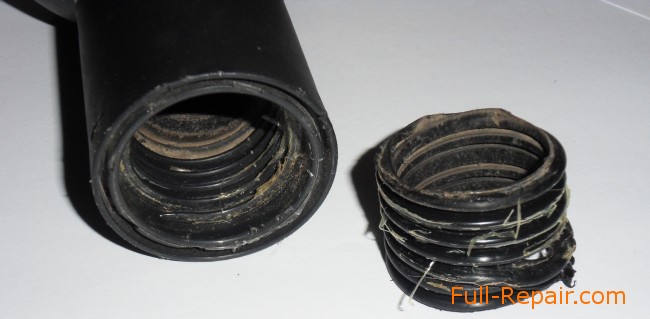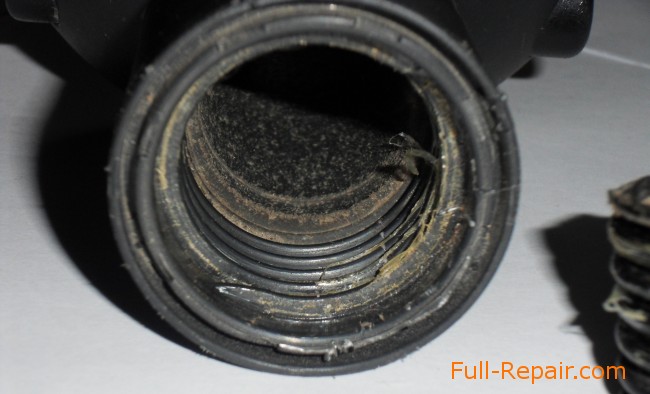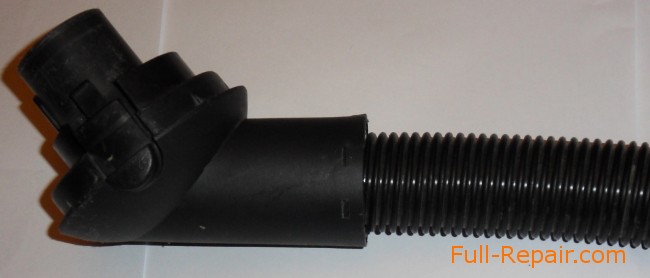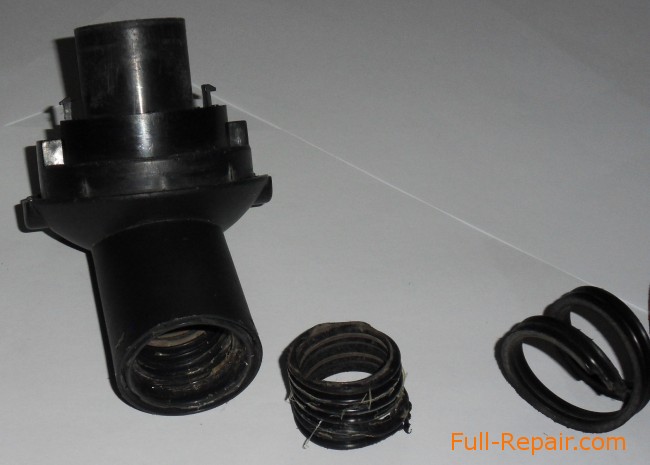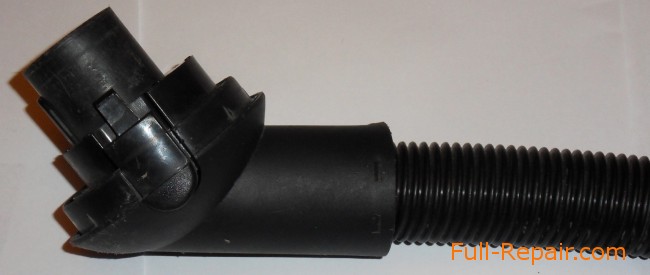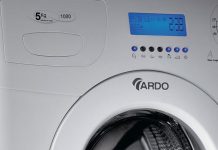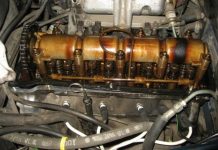VIDEO
We really hope that our recommendations for repairing a vacuum cleaner hose with your own hands will be useful and you will not have to spend money on new equipment at the most unexpected moment.
If you have torn hose of the vacuum cleaner, then do not rush to throw away the vacuum cleaner and buy a new one, especially if the old vacuum cleaner is completely tired of you: excellent suction power and the engine runs smoothly. The hose usually breaks at the strongest points. folds - this is either in the place where the hose is attached directly to the vacuum cleaner itself, or in the place near the handle of the hose holder. I have seen many times how a torn hose is wrapped with duct tape or duct tape. But in this case, such repairs are usually short-lived, and it looks somewhat rough and pathetic.
The hose can be repaired by cutting off the torn part. In this case, it will be shorter by 3-5 centimeters, but it will look and work like absolutely new .
For repairs, we took a hose with a power regulator on the hose handle:
This hose differs from the usual one in that it uses two insulated wires as a spring, through which voltage is supplied to the switch and the power regulator (rheostat) located on the holder handle. As expected, the hose broke at the point where it was attached to the vacuum cleaner:
Since this hose is wired, it has two contacts in the form of a plug for an electrical outlet, which close the electrical network when connected to the body of the vacuum cleaner:
First, you need to disassemble the mount to access the hose wires. To do this, you need to use a Phillips screwdriver. We unscrew the two self-tapping screws on the holder mount:
On the front side of the hose holder there are round technological holes for easy removal of the fastener. With the same screwdriver, gently press into these holes inward and at the same time upward to remove the spring fastening mechanism
Thus, the mechanism of the spring fastening of the hose is slightly opened:
After that, the fork with the spring-loaded mechanism of the holder is removed:
Carefully remove the spring latch:
Next, unscrew the plastic hose guide:
Unscrew counterclockwise towards ourselves. It holds tight enough, but after a few seconds it gives in:
The wires are released, and by the same twisting, the hose itself is removed from the nozzle of the vacuum cleaner:
The plastic flexible sheath of the torn part can be easily cut with ordinary scissors:
We release the wires glued to the shell from it and cut off the excess part with side cutters:
When trimming wires, note that it is best to trim an integer number of turns (one, two, three, etc.). This is necessary so that when assembling in a natural position, the suction end of the hose is directed, as before, downward, and not somewhere to the side or upward.
Next, we will use a soldering iron to solder the ends of the wires that were previously soldered to the wire - the spring, which were cut off:
Solder them again. To do this, you need to clean the new ends of the wires from insulation (you can use an ordinary construction knife):
For a better grip with solder, it is better to process the cleaned ends with rosin:
Then we solder the ends of the wires with pins to our cut part. They must not touch bare wires — pay special attention to this !
Everything is ready. Now you can reassemble what has been disassembled. When assembling, we first screw in the vacuum cleaner nozzle:
When planting wires, it is convenient to use electrical tape to fix the wires:
Also, when assembling, it is better to first install the holder with a spring fastening, and then put on the plastic hose guide, since it goes over the top of the holder:
Next, screw the screws back. That's all. We receive an updated hose. All the work took about 30-40 minutes, no more. Of course, the attachments for different brands of vacuum cleaners are different, but the principles are common to all.
Posted by admin in Washing machines 05/07/2018 Comments Off on How to repair a hose from a vacuum cleaner, the ServiceYard-comfort of your home is in your hands disabled 150 Views
In the era of the 21st century, it is unlikely that it will be possible to find a family in whose house there is no vacuum cleaner. This irreplaceable assistant is almost the main household electrical appliance in the house, and the choice of its quality, technical characteristics must be approached with knowledge. But no matter how sad, no matter what famous company this vacuum cleaner is, all the promoted brands have a weakness for tearing parts of household appliances. To our deep regret, the flexibility of hoses, even from the most durable material, is not unlimited. Seeing a gap at the bend in the hose, we ask ourselves the question - is it possible and how to repair the hose from the vacuum cleaner? This does not mean that you have to run and buy a replacement. We will now tell you how to fix a vacuum cleaner hose. Here are some simple options for repairing a damaged hose.
Depending on the location and nature of the damage, there are several ways to save your hose from the vacuum cleaner, so as not to spend money on the unplanned purchase of expensive household appliances.
If the hose has been damaged in the middle, then it can be repaired with a regular bicycle tube. To do this, you need to perform the following sequence of actions:
Assess the degree of damage and cut the length of the chamber you need, after checking the rest of the part for integrity.
The chamber must be intact and not allow air to pass through, otherwise there will be a loss of power.
It uses a camera to connect the two ends of your hose.
If you find it difficult to pull the camera onto the hose, you can use soap to lubricate the ends of the corrugated tube. This will help you repair the damaged part without much effort and further damage.
After a successful connection, unscrew the ends of the chamber and wipe dry the entire surface of the corrugation.
Cover these places with Moment glue and wrap the camera back.
Important! The glued places on top can be wrapped with electrical tape or tape - for greater reliability.
Depending on which fitting the hose came off, it is necessary:
Trim the part at the torn location.
Clean the union from dirt and residues of a broken hose.
Connect the corrugated tube to the union. In this case, do not use soap when connecting. Since the hose bends during operation, it may fall out of the fitting.
The corrugated tube from the vacuum cleaner has stiffening ribs - for efficient and convenient use. Therefore, you need to screw it into the fitting or into the base of the case with the application of glue or electrical tape.
Important! If there is a problem with an element that breaks off at both ends, then in order to repair the vacuum cleaner hose, the mechanism should be disassembled:
Using a screwdriver, remove the remaining pieces of the plastic sleeve into which the damaged element was inserted.
Next, glue the part with epoxy or sealant.
Allow to dry for a while before using.
It happens that due to the poor quality of the material, the hose begins to siphon in some places - cracks and small breaks appear in it. These unfavorable places can be corrected with a medical plaster or polyvinyl chloride (PVC) insulation.
In order to repair the hose from the vacuum cleaner by such means:
Put a patch of medical plaster with insulation carefully wound over the PVC on top of the breaks. You wind very tightly, with a small margin on both sides, because the corrugated tube can allow air to pass through.
It is possible in places where cracks have appeared, carefully cut a rigid base and wind the hose on top of each other. For tightness, rewind with tape or tape.
The quality of the repair of a damaged part of the vacuum cleaner can be checked by checking the bicycle tube:
You pour water into a bath, a bucket, or some other container, and a repaired tube is lowered.
Turn on the vacuum cleaner and put it on the “blow out” mode.
Observe where there is an air leak.
Important! Air bubbles, which will come out from under electrical tape or scotch tape, will let you know about poorly carried out repairs. If you still failed to achieve a positive result the first time and the tube from the vacuum cleaner still siphon, try again tightly wrapping it with electrical tape or tape. Just pre-wipe and dry these places from moisture.
VIDEO We hope that our tips on how to repair a vacuum cleaner hose cheaply at home will be useful to you and you will not have to purchase new equipment at the most unexpected moment for you.
Almost every home craftsman is ready to offer his own recipe for how to fix a simple hose design. That is, without a power regulator on the handle and electrical wires inside, through which electricity is supplied to the regulator.
Here you will find advice on how to properly cut the hose, and how to fix it back, and master classes on using heat shrink, and even recommendations on the use of scotch tape in this matter. Of course, the consultants of our ALM-zapchasti store categorically do not recommend using scotch tape in this matter. This does not guarantee the tightness of the hose. But even to argue with folk craftsmen is reluctant.
But the complex design of the hose with wires and a power regulator handle causes difficulties for "scotch tape masters". But, since such hoses break in the same way as ordinary ones - in places of bending (near the handle and at the point of attachment to the body), then they are repaired according to a similar principle.
The only difference is the need to use a soldering iron. However, let's talk about everything in order. So how do you fix the hose of a power regulator vacuum cleaner on the handle? For example, consider the case when the hose breaks at the point of attachment to the body of the vacuum cleaner.
1. First of all, pay attention to the two metal pins that close the electrical circuit for the power regulator on the handle. It is to them that the wires are suitable, which subsequently will have to be re-soldered.
2. Unscrew the self-tapping screws on the hose holder.
3. Press with a screwdriver inside the holes to remove the spring fastening mechanism.
4. Remove the latch at the top.
5. Unscrew the hose guide counterclockwise and remove it.
6. Then remove and cut the hose.
7. Then cut off the number of turns of wire by which you cut the length of the hose. This is necessary so that after assembly the hose remains in the correct working position, that is, with the retracting end down.
8. Next, you should unsolder the cut ends from the wires going to the pins, strip the ends of the wiring remaining in the hose and solder to the wires. Treat the stripped ends of the wiring with rosin.
9. When reassembling, be careful not to touch the exposed wires. Better yet, wrap them with duct tape. Insulation tape also comes in handy to secure the wires more securely in the mount.
Here are 9 steps you need to take if your vacuum cleaner hose breaks. We hope that these 9 steps did not turn into 9 circles of hell for you, as described by Dante Alighieri. If the proposed technology for repairing a vacuum cleaner hose seems overwhelming and difficult to digest for you, then use another valuable advice from the specialists of our ALM-zapchasti service: just buy a hose for a vacuum cleaner.
The online selection function on the site will help you do this as quickly as possible. Almost as fast as looking at the make, model, serial number of your vacuum cleaner and calling our consultant. Remember that you can purchase spare parts for vacuum cleaners from us at competitive prices, and all components come with a manufacturer's warranty.
In any case, do not rush to part with the well-established home helpers who make it easier for you to clean, maintain cleanliness and order in your home. A reliable vacuum cleaner is an indispensable item for your home. And, if in 10-15 years the only problem has become a damaged hose, then such a vacuum cleaner must be brought back to life and continue to use it further!
Regardless of the type of vacuum cleaner, the heart is called the engine. Television programs like to depict the creation of a vacuum, which, in our opinion, is an inept manipulation of words. The motor draws in air by the blade, the filter keeps the moving parts from dust. Each bearing is equipped with an insert for this purpose. The engine has no protection from vacuum ... Do-it-yourself repair of a vacuum cleaner is advisable when the heart of the device is functioning properly, there is a need to replace, modify the brushes, lubricate the bearings. It is charming that the devices are similar from the inside, like two drops of water. The mechanical part, the device for collecting dust, filters, brushes, hoses, housings vary. Accessories are an essential part of the appliance. The device of the vacuum cleaner, the basic idea remains the same!
The heart of the vacuum cleaner is rightly called a motor, traditionally a collector motor. Let's take a quick look at the design of an irreplaceable product and create a clear idea. In an asynchronous motor, a rotating field is created by correctly distributing the phases by the windings, the winding collector commutes in series. There are unpopular exceptions. The direction of movement is determined by the direction of engagement:
The current flows, the fields work for attraction.
The current flows, the fields are repelled.
As for the question why the rotor turns exactly in this direction, not opposite when connecting the windings unidirectionally, the answer is revealed by the mutual arrangement of the brushes and stator coils, the structure of the collector. The number of coils is wound on the armature, equal to the number of contact pads of the shaft. The brushes feed a single winding at a time. Then the shaft rotates a certain angular distance, the next coil is energized. One revolution passes, the cycle begins anew.
Imagine the stator pole (so far only one - not two), located at the bottom. Suppose, at the initial moment of time, the brushes are set so that the armature pole is fed to the left of the building axis. Then, due to repulsion, the shaft begins to describe the hour hand. The axis passes the angular distance, the current begins to flow around the next winding, which managed to take the place of the previous one. This happens as long as the current exists. And there is no difference, constant or variable. The collector motor will run driven by the direction of the field. The speed of rotation is not determined by the frequency - by the design of the mechanical part, by the magnitude of the voltage.
Now if the fields are attracted, the rotation will start counterclockwise. By the time the stator and rotor poles become opposite each other, the power will be transferred to the next coil, which will begin to create the required force. The cycle is circular. Now the coils. Brush motors are equipped with a pair of stator windings for direct current, because the alternating current encounters too much resistance from the inductors.This is why some brushed motors are designed with separate stator leads. It will allow you to use one instead of two windings. It is clear that the load capacity drops significantly. But losses are decreasing.
In a vacuum cleaner on the motor stator, we notice two diametrically opposite windings that help each other. Mutually beneficial coexistence is ensured by the correct direction of inclusion (wrote above). Reversing motors have a special power relay that switches the poles in proper order. For comparison, in an induction motor, a similar relay distributes the voltage phases in a different way. It turns out a reverse. The collector motor does not require a starting winding and a capacitor (one phase), which try to imitate the second winding. Simply put, the efficiency of three-phase asynchronous motors is higher. The brainchilds of Nikola Tesla and Dolivo-Dobrovolsky are used by industrial equipment, in the 90s they were replaced by collector equipment from household appliances (vacuum cleaners were traditionally supplied with graphite brushes before the restructuring).
Two brushes are used to transfer current to the armature. The difference is leveled, where the plus, where the minus, the direction is provided by the correct commutation.
Is it possible, by changing the order of connecting the brushes, to make the motor rotate in the opposite direction. The polarity of the field is reversed. This technique is used to obtain a constant voltage reverse. When doing self-repair of vacuum cleaners, remember the correct position of the contacts.
A tangential fan is hidden behind the filters for coarse and fine air purification. Air enters in the center, is discharged to the periphery, moving forward, enters the room through a HEPA filter that traps particles of a few microns (micrometers) in size. The blade is covered with a cover, the part is made in the form of curved aluminum partitions between two metal planes. Closed channels are obtained. The engine is enclosed by a plastic casing (traditionally white), in which the outlet flow path is cut.
It is interesting! Due to the presence of a tangential fan, the efficiency of the vacuum cleaner barely reaches 20-30%. With a power consumption of 1600 W, the suction will be 350 W.
Brushes are fixed in mines, it is good for beginners to know: this is a typical pencil graphite (carbon, coal). You can, if necessary, sharpen the parts, adjust as needed, so that they become in place. If the area of contact with the collector is small, it is not scary, gradually the brushes will wear in. The tips are slightly grinded in a semicircle inward. Each brush is pressed by a spring through which the current passes, the measure will provide a long service life to the products. The carbon will work until it wears down to the ground. However, the copper collector must be kept clean. Wipe with your favorite product if necessary, remove the oxide film to a coppery shine.
The shaft is attached to the stator with two bearings. Different sizes to make it easier to disassemble the vacuum cleaner motor. The front bearing is large and the rear bearing is small. The shaft is carefully knocked out of the stator by suitable means (pneumatic puller), moderate heating helps. The bearings are equipped with anthers. Although the vacuum cleaner creates a vacuum, dirt gets in there too. The anthers are carefully removed with a screwdriver if necessary to lubricate the parts. Suitable: composition HADO, Litol - 24, EP - 2. The grease is put inside, the boot is put in place.
Do-it-yourself vacuum cleaner repair begins by removing the case. In each case, the methods are different. Filters blocking access to the engine are removed. The electrical installation is disconnected (the vacuum cleaner is unplugged), the plastic motor housing is unscrewed from the base. Remove the motor from the casing, after which the fan is removed. The nut has a left-hand thread, twist carefully. The fan is followed by a collector-cover, under which the electrical part is hidden. The further course of operations is clear from what was previously read up to the removal of the rotor.
If necessary, the bearings are racked off with a threaded remover or a hydraulic press. Aids are being used. Small balls with a diameter extending into the bearings. It is recommended to flatten on one side so as not to roll. Reverse mounting is done in a similar way. If you hold the armature by the bearing in your hand, the rotation should be fast, quiet, confident. When lubricating, the outer boot is removed, take the trouble to put new spare parts on the same side.
brushes;
bearings;
motor windings;
power wire;
fuse.
VIDEO
Other vacuum cleaners have two motors. The second is located on the brush, where it makes the villi move. Cyclonic models use a turbo, moving air does the work. Constructive refinement simplifies the manufacture of the hose, eliminates one big problem when the wire breaks in the thickness of the rubber. Of course, modern means will allow you to accurately determine the location of the incident, it is better to avoid breakage altogether. The idea of the designers, who placed the motor inside the brush, is easy to understand: there is no need to press when cleaning, the weight is decent. Do you like it, decide for yourself. In the opinion of the editors, the brush should be light to make it easier to operate.
Repair of washing vacuum cleaners does not differ from that described above. However, the units contain a pump that supplies water to the hose. We will return to the question in the reviews later. As for the inlet path, the configuration does not differ from the usual one, excluding the presence of a water filter. Most look like dull boxes filled with water. In some vacuum cleaners with an aquafilter, thin streams of water hit the junction of the hose and the body. Primary dust collection is in operation. However, it is difficult to notice the malfunction. It's another matter if the vacuum cleaner is equipped with a self-diagnosis option, which will prompt the location of the breakdown.
The repair of robotic vacuum cleaners is closely related to the field of electronics. There are nothing service mechanisms at all. However, you will find the engine in a reduced size. Most of the functions are implemented in microcircuits, the memory accommodates various programs. Repairing Electrolux vacuum cleaners will seem like child's play compared to the task of adjusting the work of Rumba or Scuba by the American company iRobot (a developer of US army and police automation). A significant disadvantage of robots is the impossibility of cleaning uneven surfaces. Electronic servants lack the ability to create a vacuum ... use a rotating brush to sweep away dust.
Repairing vacuum cleaners, like other household appliances, is a common practice, since all appliances tend to break. The cause of breakdown is most often the wear of parts and the destruction of mechanisms. However, a breakdown of a vacuum cleaner does not always mean that you need to buy a new one, since it is quite possible to repair such equipment with your own hands.
The vacuum cleaner is rightfully considered the most popular piece of household appliances. Most housewives today can no longer imagine their life without a vacuum cleaner, since it significantly saves time and helps to keep the house clean and tidy.
See also - How Do I Pick a Good Vacuum Cleaner at an Affordable Price?
In most cases, the motor is the cause of the vacuum cleaner's failure. Such a breakdown occurs with almost all brands and models of the device, regardless of the manufacturer. By the characteristic signs and features of the device, you can diagnose a problem and try to repair the vacuum cleaner with your own hands.
The first sign of a malfunctioning engine is a hum and the appearance of a dusty cloud during the operation of the device.
Insufficient suction power or its complete absence indicates that the hose is out of order. Another sign that the tightness of the hose is broken is the quiet operation of the device. In addition to breakdown in the corrugation, the receiving brush can be damaged.
Slow suction speed and a drop in operating speed can be the result of bearing failure.Proof of failure of these particular components is the periodic restoration of normal operation.
Excessive hum during proper operation indicates that the engine is out of order. In most cases, malfunctions in the motor directly affect the suction power of the air.
VIDEO
See also - DIY microwave oven repair at home
No matter what the cause of the malfunction, you need to know how to disassemble the vacuum cleaner in order to repair it yourself.
Repairing a vacuum cleaner with a wet cleaning function will be a little more difficult, since you will also have to work with a water pump. The main task of the pump is to supply water to the dust collector, for this reason the pump is installed at its inlet. When repairing a washing vacuum cleaner, you must pay attention to disconnecting the pump.
See also - Do-it-yourself multicooker repair
When repairing a vacuum cleaner from the following companies: Hoover, Vitek, Samsung, Rowenta - it is recommended to check the power cord is working properly. You can check the integrity of the cord using a multimeter. The reason for the failure of the cable most often lies in the active use of the vacuum cleaner, in which the cable is frayed, twisted and broken. If such a breakdown is confirmed, it is enough just to shorten the cable to the required length or replace it.
Vacuum cleaners of the Dyson, Miele brand have a distinctive feature that manifests itself in the frequent failure of the filter. Low suction power is a sign of dirty filters.
It is very important to periodically clean and rinse not only the dust container, but also the filter. Timely maintenance of the filtration system of the vacuum cleaner is the key to its long-term and high-quality operation, which primarily depends on the serviceability of the engine.
See also - How to repair an electric kettle yourself
On our website Good luck!
Home radio - dedicated to amateur radio. The most interesting and practical circuits of devices for the home will be collected here. A series of articles on the basics of electronics for beginner radio amateurs is planned.
Electrician - given detailed installation and schematic diagrams concerning electrical engineering. You will understand that there are times when it is not necessary to call an electrician. You can solve most of the questions yourself.
Radio and Electrics for beginners - all information in the section will be completely devoted to novice electricians and radio amateurs.
Satellite - describes the principle of operation and configuration of satellite television and the Internet
Computer - You will learn that it is not such a terrible beast, and that you can always cope with it.
We repair ourselves - illustrative examples are given for the repair of household items: remote control, mouse, iron, chair, etc.
Homemade recipes - this is a "tasty" section, and it is completely devoted to culinary.
miscellanea - a large section covering a wide range of topics. These are hobbies, hobbies, useful advice, etc.
Useful little things - in this section you will find useful tips that can help you in solving everyday problems.
For home gamer - the section is entirely devoted to computer games and everything connected with them.
Works of readers - the section will publish articles, works, recipes, games, advice from readers related to the topic of home life.
Dear visitors !novice radio amateurs .
By purchasing this book, you will answer almost all questions related to capacitors that arise at the first stage of radio amateurism.
Dear visitors !
By purchasing this book, you no longer have to look for information about magnetic starters. Everything that is required for their maintenance and operation, you will find in this book.
Dear visitors !
VIDEO
Dear visitors !
Video (click to play).
VIDEO
